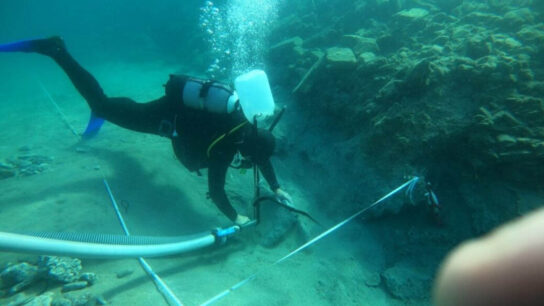Archaeologists believe that a distinguished Bronze Age man who underwent brain surgery 3,500 years ago may have had leprosy
While excavating a 3,500-year-old tomb in Tel Megiddo, Israel, scientists discovered a skull with a surprising feature: a square hole that’s clear evidence of ancient brain surgery.
Nobody knows whose steady hands performed the operation, or what experience made the surgeon feel prepared to remove part of a living human’s cranium. Was the patient administered some anesthesia or a mind-altering substance? Or was he left to experience the operation in excruciating pain? And what desperate straits or last-ditch hopes led to such an extreme step?
“I can only hypothesize based on the amount of pathological evidence that is on this individual that this was an intervention because of deteriorating conditions,” says Rachel Kalisher, a bioarchaeologist at Brown University. “But we don’t really have a clear answer.”
Kalisher’s theory is that the brothers’ social status may have afforded them the care and resources to survive their disease longer than the less fortunate. After one brother died, the other might have sought out skull surgery in a desperate attempt to relieve his debilitating symptoms—one that sadly proved unsuccessful.
The brothers, identified as siblings through analysis of their ancient DNA, were buried underneath the floors of their family home in the wealthy Bronze Age city that straddled trade routes between Egypt, Syria-Mesopotamia and Anatolia. The fortified urban center is rich with temples and monumental architecture.

The then-common practice of burying the deceased in the family home is a boon for archaeologists, as it allows researchers to match human remains with the locations the person frequented and the artifacts they used in life. The brothers’ final resting place was a residence with upscale architecture, fine examples of pottery and worked bone, and precious metals, which all point to a well-to-do family. The site was in a prime spot, close to the palace and the city’s main entrance gate. The brothers were also afforded burial rites appropriate for the upper class: They were entombed with fine pottery and offerings of food.
Analysis of the grave and body positions reveals that one brother died in his late teens or early twenties and was buried one to three years before the other. When his sibling succumbed after his unsuccessful surgery, at age 21 or older, the previously deceased brother was exhumed so the two could be buried together—a common practice in the area during the Bronze Age.
Kalisher sees the joint burial as a reaffirmation of the familial and social connections between the siblings. They were presumably cared for during long illnesses, and they were afforded the same burial rites and traditions as others of their status, suggesting that their society valued them despite their debilitating conditions.
The brothers suffered from multiple ailments. Their skeletons show signs of congenital or developmental anomalies, like additional teeth that did not erupt. The brother who had the trepanation also had skull bones that didn’t fuse together normally during infancy. Both siblings’ bones also show infectious lesions acquired through an as-yet-unknown disease, which might have been leprosy. The skeletons’ many lesions likely show that they lived with the disease for an extended period of time.
Socioeconomics may have something to do with how the brothers survived. “If people have the means to access medical care or a special diet, they might survive longer than individuals who didn’t have those means,” Kalisher says.
In the heavily studied Levant region—which includes Syria, Lebanon, Jordan, Israel and the Palestinian territories—relatively few examples of trepanation have turned up. Researchers have uncovered only about a dozen cases. “This may reflect how infrequently these things occurred in the past,” Kalisher notes.
Cut marks on the skull show where the scalp was opened up, the first step in the procedure. The ancient surgeon then removed a 1.2-inch-square piece of the skull’s frontal bone, apparently by making a series of parallel, groovelike cuts and later prying loose pieces of skull away, which were found among the skeletal remains.
Kalisher and colleagues believe that the patient was alive when the operation was performed. The color and beveling of the hole’s edges show the cut was made into living bone, and care was taken not to puncture the tissue overlaying the brain. But because no signs of post-operation bone growth exist, it seems likely that the patient died during the surgery or shortly thereafter.

Trepanation was practiced across the ancient world both for medical reasons, like easing trauma from a head injury and for seemingly ritual ones, like releasing evil spirits from the head. Evidence of such surgeries dating back thousands of years has been found across Africa, with one study claiming to have uncovered an example as early as 7,000 years ago in Sudan. A mummified woman from a tomb in China’s Xinjiang Uygur Autonomous Region shows that trepanation was practiced there by 1600 B.C.E ancient brain surgery. The Greeks and Romans adopted the practice, which continued through Europe’s medieval era.
But ancient brain surgery appears to have been most common in the Americas, among the Andes people of Peru and Bolivia. Tulane University anthropologist John Verano wrote the book on the practice there and has documented more than 800 cases in the region—perhaps as many as across the rest of the ancient world combined. By the time of the Incas, circa 1400 to 1500 C.E., survival rates from such operations reached an amazing 75 or 80 percent.




